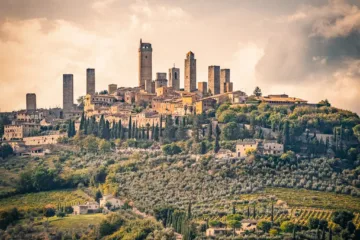
Winemaking has a long and rich history in Greece’s Goumenissa region, reaching back to ancient times. The region is noted for producing high-quality red wines made mostly from the Xinomavro grape, which flourishes in the chilly climate and limestone soils of the region. The modern winemaking business in Goumenissa started in the early twentieth century, when local farmers formed cooperatives to promote grape planting and wine production. Today, Goumenissa wines are highly appreciated both in Greece and abroad, and the region is a popular wine tourism destination. Stay with us until the end of the article to find out everything you need to know about the winemaking region of Goumenissa.
A short history about winemaking in Goumenissa
Goumenissa, located in the prefecture of Kilkis at the foothills of Mount Paikos, has been producing red wine for generations. At one time it had more than a thousand wine presses, since by 1918 more than 110 hectares of vineyards were cultivated. Then arrived the infamous phylloxera.
Like many winemaking regions all over the world, Goumenissa was also affected by the disease and had to eventually be replanted using American rootstock. In the mid-1920s, the refugees from Eastern Rumelia, mastering the technique of grafting, started to revive the viticulture in the region. These refugees worshiped Saint Tryphonas, the protector of viticulturists, and since then, as a tradition, every February 1st feasts are held in his honor.
In 1979, the Goumenissa Designation of Origin zone was established, which at that time was the smallest zone in Greece and, later on, viticulture slowly but steadily spread to the surrounding villages. In order for a wine to be labeled as PDO Goumenissa, it has to be a dry red made from the varieties Xinomavro and Negoska (at least 20 %) and the grapes must be harvested from vineyards located at an altitude of at least 150 meters.
Terroir

Goumenissa’s terroir is characterized by its relatively high altitude, cool temperature as well as its mineral-rich and well-drained soils. The region is located at an altitude of roughly 200-300 meters above sea level, which provides cooler temperatures, ideal for growing the region’s main red grape varieties, Xinomavro and Negoska. The soil in the region is also a key aspect in Goumenissa’s terroir. The soils are predominantly sandy and loamy, with significant limestone and clay concentration. This type of soil drains water effectively, which helps to regulate the amount of water received by the vines and also contributes to the minerality of the wines. Finally, most of the vineyards in the area are trained using the ‘gobelet training method’, which helps to protect the vines from the sun and wind, and encourages a lower yield of higher-quality grapes.

Varieties
The two main in indigenous varieties of the region are Xinomavro and Negoska. Xinomavro is a red grape, known for its high acidity, firm tannins, and complex flavors that are often described as reminiscent of black cherry, tomato, olive, and spices. Xinomavro is the dominant grape variety in the Goumenissa appellation. It is used to produce both red and rosé wines. Negoska is also a red grape variety that is known for its fruity aromas and flavors, which are often associated to strawberries and raspberries. Other native varieties cultivated in the area are the Roditis, Lemnos, Malagouzia and Assyrtiko. Of international varieties, Cabernet Sauvignon, Syrah, Merlot, Sauvignon Blanc and Chardonnay are also grown in Goumenissa.
Food Pairing

PDO Goumenissa wines are relatively tannic and should be paired with dishes that balance them. However the flavors of the wine can easily get lost in too rich pairings. If you want to experience the local cuisine, I recommend pairing a Goumenissa wine with a mincemeat pie, beef with bulgur or, the traditional Greek recipe called ‘Gigantes Plaki’ (local giant beans mijoted in a tomato sauce usually served with Feta cheese on top). Otherwise, a wild mushroom risotto with parmesan flakes or a platter with aged cheeses will work equally as well.
My preferred wineries in Goumenissa
The Boutaris Winery
The Boutaris family (also written Boutari) owns six wineries in Greece, one of which is located in Goumenissa. The privately owned Boutaris estate, which is now cultivated organically, was established in 1991 and has since become a model vineyard for the region and Greece in general. This is where the “Filyria Boutari” wine is made, a fine blend of Xinomavro and Negoska aged for 12 months in French oak barrels from grapes grown organically in the privately owned Boutari vineyard. Another wine you shouldn’t miss on trying is the “Goumenissa Boutari” (click here for my Tasting note of the 2018 vintage) that would also make an excellent gift for a wine lover since it’s suitable for extended cellaring.

The Domaine Tatsis
The Tatsis brothers, Perikles and Stergios, are the third generation winemakers of the family. They wanted to change everything when they took over Tatsis Winery after their father. So, they established a “green” vineyard that is now certified organic. The estate is well-known for its raw and unfiltered Negoska, Roditis and Xinomavro wines all made from indigeneous yeasts. They have made a 100% Negoska red wine (click here for a full tasting note of the 2014 vintage), which has never been done before, as this grape variety is generally used as a “helping” vine in the DOC Goumenissa. Their “Angel’s Heart Negoska” is definitely worth trying if you come across it.
The Chatzivariti Winery
For the Chatzivariti Winery, it all started in 1994 when Vangelis Hadjivaritis planted the first vineyard of 50 acres in the area of Bidampla. Emphasizing the quality of the grapes, the fertility of the soil and the protection of the environment, he chose organic farming from the very beginning. The expansion of the vineyard was inevitable and was done gradually, Today the estate’s vineyard consists of 200 acres. The Hatzivaritis Estate produces two lines of wines, one with seven organic wine labels and one with eight minimal intervention wines. Their organic wines have received multiple awards over the years, so I really recommend you to give them a try (click here for a full tasting note on their Goumenissa Red of 2015).
The Mikro Ktima Titos
Titos Eftychidis started the “Small Estate of Titos” (= Mikro Ktima Titos) vineyard in 1972, planting a 4-hectare vineyard with the varieties Xinomavro, Negoska, Cabernet Sauvignon, Limnio, and Viognier. The goal was and still is to produce first-rate wines from indigenous grape varieties. The vines are farmed according to organic agricultural standards and tended with care and respect for the ‘terroir’ differences.
The property was reconfigured, and renovation work on the old building was completed in 2022. As a result, the winery is elegant and welcoming, with fully-equipped wine making facilities, purpose-built maturation cellar and even includes a visitor welcome center. (Click here for full tasting note of the Goumenissa red 2018 from Mikro Ktima Titos)

Follow me on my Social Media
Wine is a gourmet treasure, do not abuse alcohol!
None of this content has been sponsored
I did not receive any gifts or free samples that could be related to this article






